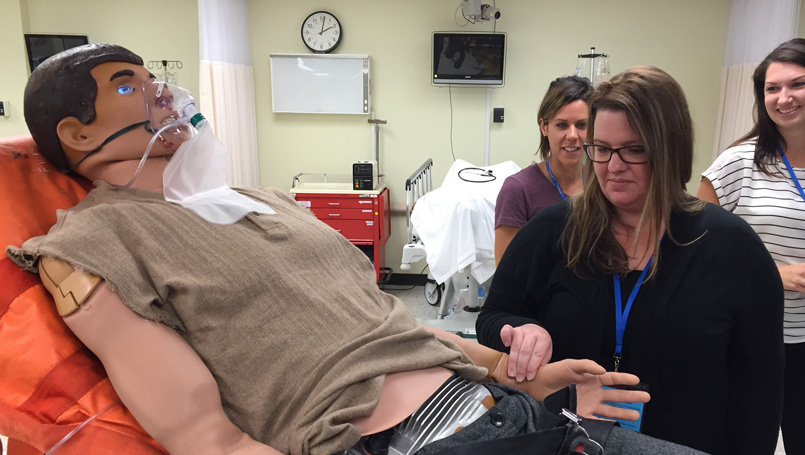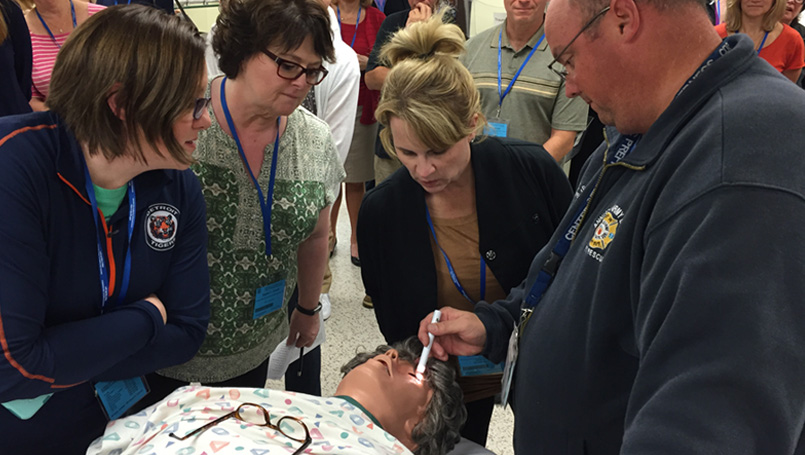Wednesday, November 02, 2016

Terrorism. Natural disasters. Manufacturing plant explosions. Fires. Any of these emergencies could happen in our community without warning. Are you prepared for an emergency in your home? FEMA recommends creating your own emergency supply kit that includes a first aid materials, water and even extra daily medications.
During times of crisis, it is also critical that doctors and nurses at hospitals and first responders from EMS and local fire and police agencies are also prepared and work together effectively as a team.
More than 70 Beaumont Health employees and representatives from 17 local agencies traveled to FEMA’s Center for Domestic Preparedness near Anniston, Alabama, Oct. 16-22, to practice responding to disasters.
“What we learned was critical,” said Maureen D’Agostino, vice president of System Performance Excellence for Beaumont Health. “We have a large footprint in Southeast Michigan. In the event of a disaster, people will come to our hospitals.”
The Department of Homeland Security uses the National Incident Management System to respond to catastrophic events. NIMS was developed after 9/11 to provide a common structure for all agencies to follow when responding to a regional event— whether it’s a terrorist attack, an environmental disaster or a large sporting event. FEMA also created a website that includes valuable information about how to prepare to protect your family, property and community from natural and manmade disasters.
Cristy Rankin, director of System Emergency Management for Beaumont Health, coordinated the FEMA training for the team that traveled to Alabama. “We had every discipline in the hospital covered,” Rankin said. “Everyone gets involved. Everyone has to work together.”
The first four days involved a combination of classroom instruction, table-top exercises and live drills that used role-players and trauma simulation mannequins as victims. The drills took place at “Noble Hospital,” a once-functional hospital that now serves as a real-world learning environment. On the last day of training, all teams participated in an Integrated Capstone Event designed to test everything they had learned.

Life-like, robotic mannequins helped students learn critical skills during the training.
“I think it exponentially increased our ability to take care of people in any kind of mass casualty situation,” said Kevin Scheid, an Oakland County Homeland Security specialist and former fire chief. “It’s one thing to read about or talk about how you would respond in a disaster. It’s another to actually see it happen during a training exercise.”
Throughout the exercises, participants were reminded to “think local, act global,” recognizing their role in the larger environment while they attended to their specific tasks.
“As a physician in the Emergency Center, we are very involved in a disaster, but knowing how the entire system works improves our ability to provide good care and understand what happens throughout the hospital even before the first patient comes to us,” said Alex Rhea, M.D., an Emergency Center physician at Beaumont Hospital, Royal Oak.
In the final scenario, terrorists caused an explosion in a subway system that injured dozens and released Sarin gas. First responders had to: treat victims at the scene, set up decontamination units, identify the biological threat, provide safe evacuation, communicate with the public and each other—all while dealing with other unpredictable events that occur in a hospital every day.
Those who took part were as impressed with the size and scope of the exercise as they were with the quality of instruction leading up to it. Arash Armin, D.O., head of Emergency Operations at Beaumont Hospital, Trenton, said his team treated more than 130 patients in an hour.
“It opens your eyes,” he said. “I don’t think you could ever be fully prepared for something like this, but you have to know exactly what you have in the hospital and what you can do.”
Instructors also said they were impressed with the Beaumont team.

“I’ve never received as many positive comments by the training cadre on how motivated the students were and the positive attitude everyone had,” said Dan Cody, who heads up resident training in the central region for the CDP. “The course managers told me the bar was now set for future course participants to reach.”
Those who took part said they had many ideas to bring back to the organization. Keith Ciaramitaro, emergency preparedness coordinator at Beaumont Hospital, Farmington Hills, said, “It allowed us to work with people from across Beaumont Health. Relationships and knowing the other people involved in the organization helps you respond better to the community.”
